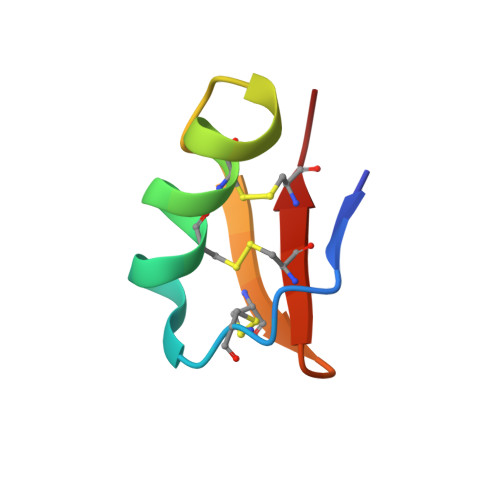Interaction of a toxin from the scorpion Tityus serrulatus with a cloned K+ channel from squid (sqKv1A).
Ellis, K.C., Tenenholz, T.C., Jerng, H., Hayhurst, M., Dudlak, C.S., Gilly, W.F., Blaustein, M.P., Weber, D.J.(2001) Biochemistry 40: 5942-5953
- PubMed: 11352729
- DOI: https://doi.org/10.1021/bi010173g
- Primary Citation of Related Structures:
1HP2 - PubMed Abstract:
A toxin from the scorpion Tityus serrulatus (TsTX-Kalpha) blocks native squid K(+) channels and their cloned counterpart, sqKv1A, at pH 8 ((native)K(d) approximately 20 nM; (sqKv1A)K(d) approximately 10 nM). In both cases, decreasing the pH below 7.0 significantly diminishes the TsTX-Kalpha effect (pK = 6.6). In the cloned squid channel, the pH dependence of the block is abolished by a single point mutation (H351G), and no change in toxin affinity was observed at higher pH values (pH > or =8.0). To further investigate the TsTX-Kalpha-sqKv1A interaction, the three-dimensional structure of TsTX-Kalpha was determined in solution by NMR spectroscopy, and a model of the TsTX-Kalpha-sqKv1A complex was generated. As found for other alpha-K toxins such as charybdotoxin (CTX), site-directed mutagenesis at toxin residue K27 (K27A, K27R, and K27E) significantly reduced the toxin's affinity for sqKv1A channels. This is consistent with the TsTX-Kalpha-sqKv1A model reported here, which has K27 of the toxin inserted into the ion conduction pathway of the K(+) channel. This toxin-channel model also illustrates a possible mechanism for the pH-dependent block whereby lysine residues from TsTX-Kalpha (K6 and K23) are repelled by protonated H351 on sqKv1A at low pH.
Organizational Affiliation:
Department of Biochemistry, University of Maryland School of Medicine, Baltimore, Maryland 21201, USA.














